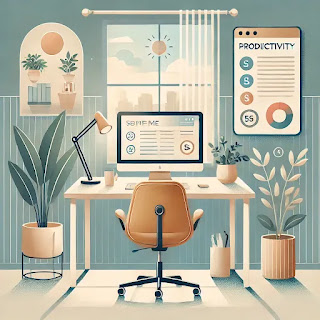A well-designed workspace can significantly impact productivity, creativity, and overall job satisfaction. Whether you work from home, in an office, or a hybrid setup, creating an environment that supports focus and efficiency is crucial. Here are 10 actionable tips to help you design a workspace that enhances productivity.
1. Choose the Right Location
Prioritize Comfort and Minimal Distractions Selecting the right spot for your workspace is the first step. A quiet area away from household or office traffic ensures better concentration.
Action Steps:
Identify a location with minimal noise and interruptions.
If space is limited, consider noise-canceling headphones.
2. Optimize Lighting
Natural Light Is Key Good lighting reduces eye strain and improves mood. Whenever possible, position your workspace near a window for natural light.
Action Steps:
Use task lighting to brighten specific areas.
Consider adjustable LED lamps for customizable brightness.
Avoid placing screens directly in front of or behind light sources to prevent glare.
3. Invest in Ergonomic Furniture
Comfort Supports Productivity Uncomfortable furniture can lead to physical discomfort and decreased focus. Ergonomic chairs and desks promote proper posture and long-term well-being.
Action Steps:
Choose an adjustable chair that supports your back.
Set your desk height to allow your arms to rest comfortably.
Use a footrest if needed to ensure your feet are flat.
4. Declutter Regularly
A Clear Space Equals a Clear Mind Clutter can be a significant distraction. Keeping your workspace tidy helps maintain focus and reduces stress.
Action Steps:
Allocate 5-10 minutes daily to tidy up your workspace.
Use organizers, drawers, or shelves for storage.
Adopt a minimalist approach, keeping only essentials on your desk.
5. Incorporate Greenery
Boost Mood and Creativity Adding plants to your workspace improves air quality and enhances mood. Studies show that greenery can increase productivity by up to 15%.
Action Steps:
Start with low-maintenance plants like succulents or pothos.
Place plants in areas that receive adequate light.
Rotate plants occasionally to keep the space fresh.
6. Personalize Your Space
Make It Your Own Personal touches make your workspace inviting and motivate you to spend time there. However, avoid over-personalization that can lead to distractions.
Action Steps:
Add framed photos, inspirational quotes, or artwork.
Use decorative items that reflect your personality.
Keep personal items limited to avoid clutter.
7. Use Technology to Your Advantage
Streamline Your Workflow The right tools can significantly enhance your efficiency. From productivity apps to hardware, invest in technology that simplifies your tasks.
Action Steps:
Use apps like Trello, Notion, or Slack for organization and communication.
Ensure a reliable internet connection and updated software.
Invest in dual monitors for multitasking.
8. Establish Zones for Different Activities
Separate Work from Leisure Dedicated zones help your brain associate specific areas with particular activities, improving focus and preventing distractions.
Action Steps:
Create separate zones for meetings, focused work, and breaks.
Use physical dividers or furniture placement to define these areas.
Avoid blending workspaces with leisure areas like beds or sofas.
9. Control Noise Levels
Minimize Distractions Noise can be one of the biggest disruptors in a workspace. Controlling it enhances focus and productivity.
Action Steps:
Use white noise machines or apps for background noise.
Install soundproofing panels if needed.
Communicate with family or colleagues about quiet times.
10. Take Regular Breaks
Refresh to Recharge No workspace is effective if it doesn’t encourage breaks. Short breaks boost focus and prevent burnout.
Action Steps:
Follow the Pomodoro Technique: 25 minutes of work followed by a 5-minute break.
Incorporate movement, like stretching or walking, during breaks.
Use timers or apps to remind you to step away periodically.



